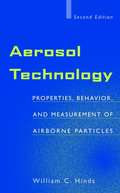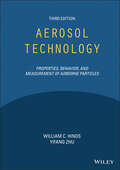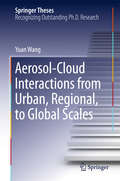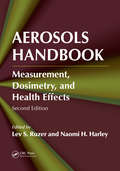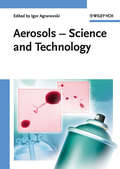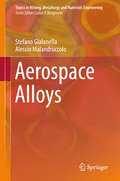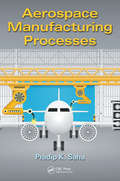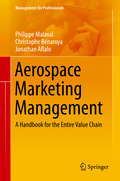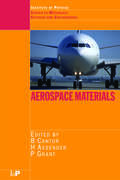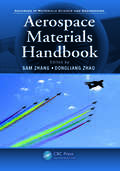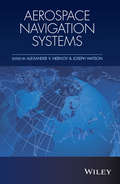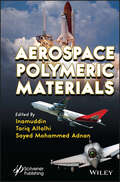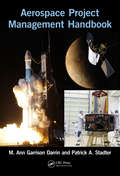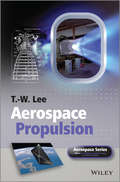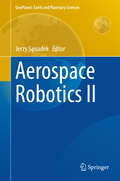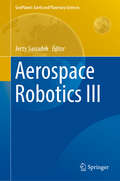- Table View
- List View
Aerosol Technology
by William C. HindsThe #1 guide to aerosol science and technology -now better than everSince 1982, Aerosol Technology has been the text of choice among students and professionals who need to acquire a thorough working knowledge of modern aerosol theory and applications. Now revised to reflect the considerable advances that have been made over the past seventeen years across a broad spectrum of aerosol-related application areas - from occupational hygiene and biomedical technology to microelectronics and pollution control -this new edition includes:* A chapter on bioaerosols* New sections on resuspension, transport losses, respiratory deposition models, and fractal characterization of particles* Expanded coverage of atmospheric aerosols, including background aerosols and urban aerosols* A section on the impact of aerosols on global warming and ozone depletion.Aerosol Technology, Second Edition also features dozens of new, fully worked examples drawn from a wide range of industrial and research settings, plus new chapter-end practice problems to help readers master the material quickly.
Aerosol Technology: Properties, Behavior, and Measurement of Airborne Particles
by William C. Hinds Yifang ZhuAEROSOL TECHNOLOGY An in-depth and accessible treatment of aerosol theory and its applications The Third Edition of Aerosol Technology: Properties, Behavior, and Measurement of Airborne Particles delivers a thorough and authoritative exploration of modern aerosol theory and its applications. The book offers readers a working knowledge of the topic that reflects the numerous advances that have been made across a broad spectrum of aerosol-related application areas. New updates to the popular text include treatments of nanoparticles, the health effects of atmospheric aerosols, remote sensing, bioaerosols, and low-cost sensors. Additionally, readers will benefit from insightful new discussions of modern instruments. The authors maintain a strong focus on the fundamentals of the discipline, while providing a robust overview of real-world applications of aerosol theory. New exercise problems and examples populate the book, which also includes: Thorough introductions to aerosol technology, key definitions, particle size, shape, density, and concentration, as well as the properties of gases Comprehensive explorations of uniform particle motion, particle size statistics, and straight-line acceleration and curvilinear particle motion Practical discussions of particle adhesion, Brownian motion and diffusion, thermal and radiometric forces, and filtration In-depth examinations of sampling and measurement of concentration, respiratory deposition, coagulation, condensation, evaporation, and atmospheric aerosols Perfect for senior undergraduate and junior graduate students of science and technology, Aerosol Technology: Properties, Behavior, and Measurement of Airborne Particles will also earn a place in the libraries of professionals working in industrial hygiene, air pollution control, climate science, radiation protection, and environmental science.
Aerosol-Cloud Interactions from Urban, Regional, to Global Scales (Springer Theses)
by Yuan WangThe studies in this dissertation aim at advancing our scientific understandings about physical processes involved in the aerosol-cloud-precipitation interaction and quantitatively assessing the impacts of aerosols on the cloud systems with diverse scales over the globe on the basis of the observational data analysis and various modeling studies. As recognized in the Fifth Assessment Report by the Inter-government Panel on Climate Change, the magnitude of radiative forcing by atmospheric aerosols is highly uncertain, representing the largest uncertainty in projections of future climate by anthropogenic activities. By using a newly implemented cloud microphysical scheme in the cloud-resolving model, the thesis assesses aerosol-cloud interaction for distinct weather systems, ranging from individual cumulus to mesoscale convective systems. This thesis also introduces a novel hierarchical modeling approach that solves a long outstanding mismatch between simulations by regional weather models and global climate models in the climate modeling community. More importantly, the thesis provides key scientific solutions to several challenging questions in climate science, including the global impacts of the Asian pollution. As scientists wrestle with the complexities of climate change in response to varied anthropogenic forcing, perhaps no problem is more challenging than the understanding of the impacts of atmospheric aerosols from air pollution on clouds and the global circulation.
Aerosols Handbook: Measurement, Dosimetry, and Health Effects, Second Edition
by Lev S. Ruzer Naomi H. HarleyWith the rapid growth of the nanotechnology industry, the need to understand the biological effects of aerosol exposure has become increasingly important. Featuring contributions by leading experts in the field, Aerosols Handbook: Measurement, Dosimetry, and Health Effects, Second Edition offers an up-to-date overview of many aspects of aerosols, f
Aerosols: Science and Technology
by Igor AgranovskiThis self-contained handbook and ready reference examines aerosol science and technology in depth, providing a detailed insight into this progressive field. As such, it covers fundamental concepts, experimental methods, and a wide variety of applications, ranging from aerosol filtration to biological aerosols, and from the synthesis of carbon nanotubes to aerosol reactors. Written by a host of internationally renowned experts in the field, this is an essential resource for chemists and engineers in the chemical and materials disciplines across multiple industries, as well as ideal supplementary reading in graduate level courses.
Aerospace Actuators
by Jean-Charles MaréThis book is the third in a series dedicated to aerospace actuators. It uses the contributions of the first two volumes to conduct case studies on actuation for flight controls, landing gear and engines. The actuation systems are seen in several aspects: signal and power architectures, generation and distribution of hydraulic or mechanical power, control and reliability, and evolution towards more electrical systems. The first three chapters are dedicated to the European commercial airplanes that marked their era: Caravelle, Concorde, Airbus A320 and Airbus A380. The final chapter deals with the flight controls of the Boeing V-22 and AgustaWestland AW609 tiltrotor aircraft. These address concerns that also apply to electromechanical actuators, which should be fitted on more electrical aircraft in the future. The topics covered in this series of books constitute a significant source of information for individuals and engineers from a variety of disciplines, seeking to learn more about aerospace actuation systems and components.
Aerospace Actuators, Volume 1: Needs, Reliability and Hydraulic Power Solutions
by Jean-Charles MaréThis book is the first of a series of volumes that cover the topic of aerospace actuators following a systems-based approach. This first volume provides general information on actuators and their reliability, and focuses on hydraulically supplied actuators. Emphasis is put on hydraulic power actuators as a technology that is used extensively for all aircraft, including newer aircraft. Currently, takeovers by major corporations of smaller companies in this field is threatening the expertise of aerospace hydraulics and has inevitably led to a loss of expertise. Further removal of hydraulics teaching in engineering degrees means there is a need to capitalize efforts in this field in order to move it forward as a means of providing safer, greener, cheaper and faster aerospace services. The topics covered in this set of books constitute a significant source of information for individuals and engineers seeking to learn more about aerospace hydraulics.
Aerospace Actuators: Signal-by-Wire and Power-by-Wire
by Jean-Charles MaréThis book is the second in a series of volumes that cover the topic of aerospace actuators following a systems-based approach.This second volume brings an original, functional and architectural vision to electric aerospace actuators. The aspects of signal (Signal-by-Wire) and power (Power-by-Wire) are treated from the point of view of necessity, their evolution throughout history, and operational solutions both existing and in development. This volume is based on an extensive bibliography, numerous supporting examples and orders of magnitude which refer to flight commands and landing gear for various aircraft (planes, helicopters and missile launchers) in commercial, private and military applications. The topics covered in this set of books constitute a significant source of information for individuals and engineers from a variety of disciplines, seeking to learn more about aerospace hydraulics.
Aerospace Alloys (Topics in Mining, Metallurgy and Materials Engineering)
by Stefano Gialanella Alessio MalandruccoloThis book presents an up-to-date overview on the main classes of metallic materials currently used in aeronautical structures and propulsion engines and discusses other materials of potential interest for structural aerospace applications. The coverage encompasses light alloys such as aluminum-, magnesium-, and titanium-based alloys, including titanium aluminides; steels; superalloys; oxide dispersion strengthened alloys; refractory alloys; and related systems such as laminate composites. In each chapter, materials properties and relevant technological aspects, including processing, are presented. Individual chapters focus on coatings for gas turbine engines and hot corrosion of alloys and coatings. Readers will also find consideration of applications in aerospace-related fields. The book takes full account of the impact of energy saving and environmental issues on materials development, reflecting the major shifts that have occurred in the motivations guiding research efforts into the development of new materials systems. Aerospace Alloys will be a valuable reference for graduate students on materials science and engineering courses and will also provide useful information for engineers working in the aerospace, metallurgical, and energy production industries.
Aerospace Clinical Psychology (Studies in Aviation Psychology and Human Factors)
by Raymond E. KingFlight training and flying are hazardous activities that demand the most of human operators, whether they be pilots or other factors (maintainers, air traffic controllers, managers, regulators) involved in the complex aviation system. 'Aerospace Clinical Psychology' serves as a handbook for dealing with aviators and other operators, those seen as patients as well as those functioning 'normally', who none-the-less wish to improve their performance. This book has much to offer the audiences who intersect the Human Factors and clinical areas of aviation and operators in extreme environments. It deftly defines specific touchstone areas such as selection, training, accident investigation, measurement and testing, and practical interventions. The little-margin-for-error realm of aviation exposes operators to stress and risk on a daily basis. 'Aerospace Clinical Psychology' provides a blueprint for combining the talents of clinical psychologists with flight surgeons and Human Factors practitioners to enhance safety and efficiency.
Aerospace Manufacturing Processes
by Pradip K. SahaManufacturing processes for aircraft components include broad activities consisting of multiple materials processing technologies. This book focuses on presenting manufacturing process technologies exclusively for fabricating major aircraft components. Topics covered in a total of twenty chapters are presented with a balanced perspective on the relevant fundamentals and various examples and case studies. An individual chapter is aimed at discussing the scope and direction of research and development in producing high strength lighter aircraft materials, and cost effective manufacturing processes are also included.
Aerospace Marketing Management: A Handbook for the Entire Value Chain (Management for Professionals)
by Philippe Malaval Christophe Bénaroya Jonathan AflaloThis book presents an overall picture of both B2B and B2C marketing strategies, concepts and tools, in the aeronautics sector. This is a significant update to an earlier book successfully published in the nineties which was released in Europe, China, and the USA. It addresses the most recent trends such as Social Marketing and the internet, Customer Orientation, Project Marketing and Con current Engineering, Coopetition, and Extended Enterprise. Aerospace Marketing Management is the first marketing handbook richly illustrated with executive and expert inputs as well as examples from parts suppliers, aircraft builders, airlines, helicopter manufacturers, aeronautics service providers, airports, defence and military companies, and industrial integrators (tier-1, tier-2). This book is designed as a ready reference for professionals and graduates from both Engineering and Business Schools.
Aerospace Materials (Series in Materials Science and Engineering)
by Patrick Grant Brian Cantor Hazel AssenderAerospace Materials provides a grounding in state-of-the-art aerospace materials technology, including developments in aluminum, titanium, and nickel alloys, as well as polymers and polymer composites. Experts in each topic have contributed key overviews that summarize current knowledge and indicate future trends. The book begins by outlining the i
Aerospace Materials Handbook (Advances in Materials Science and Engineering)
by Sam Zhang Dongliang ZhaoWhether an airplane or a space shuttle, a flying machine requires advanced materials to provide a strong, lightweight body and a powerful engine that functions at high temperature. The Aerospace Materials Handbook examines these materials, covering traditional superalloys as well as more recently developed light alloys. Capturing state-of-the-art d
Aerospace Materials and Material Technologies: Volume 1: Aerospace Materials (Indian Institute of Metals Series)
by N. Eswara Prasad R. J. H. WanhillThis book is a comprehensive compilation of chapters on materials (both established and evolving) and material technologies that are important for aerospace systems. It considers aerospace materials in three Parts. Part I covers Metallic Materials (Mg, Al, Al-Li, Ti, aero steels, Ni, intermetallics, bronzes and Nb alloys); Part II deals with Composites (GLARE, PMCs, CMCs and Carbon based CMCs); and Part III considers Special Materials. This compilation has ensured that no important aerospace material system is ignored. Emphasis is laid in each chapter on the underlying scientific principles as well as basic and fundamental mechanisms leading to processing, characterization, property evaluation and applications. This book will be useful to students, researchers and professionals working in the domain of aerospace materials.
Aerospace Materials and Material Technologies: Volume 2: Aerospace Material Technologies (Indian Institute of Metals Series)
by N. Eswara Prasad R.J.H. WanhillThis book is a comprehensive compilation of chapters on materials (both established and evolving) and material technologies that are important for aerospace systems. It considers aerospace materials in three Parts. Part I covers Metallic Materials (Mg, Al, Al-Li, Ti, aero steels, Ni, intermetallics, bronzes and Nb alloys); Part II deals with Composites (GLARE, PMCs, CMCs and Carbon based CMCs); and Part III considers Special Materials. This compilation has ensured that no important aerospace material system is ignored. Emphasis is laid in each chapter on the underlying scientific principles as well as basic and fundamental mechanisms leading to processing, characterization, property evaluation and applications. This book will be useful to students, researchers and professionals working in the domain of aerospace materials.
Aerospace Mechatronics and Control Technology: Selected Contributions from 2021 7th Asia Conference on Mechanical Engineering and Aerospace Engineering (Springer Aerospace Technology)
by Huafeng DingThis book collects chapters on Aerospace Mechatronics and Control Technology as selected contributions from the 7th Asia Conference on Mechanical Engineering and Aerospace Engineering (MEAE) in 2021. The book focuses on novel techniques for aviation infrastructure in aerospace mechatronics and avionics systems, mechanical engineering in aerospace, and mechanical design and control system domains. The contents make valuable contributions to academic researchers and engineers in the industry.The MEAE 2021 provides a forum to discuss the latest trends and advances in mechanical engineering and aerospace engineering and related fields, and foster the exchange of ideas and international collaboration in the field.
Aerospace Navigation Systems
by Alexander Nebylov Joseph WatsonCompiled by leading authorities, Aerospace Navigation Systems is a compendium of chapters that present modern aircraft and spacecraft navigation methods based on up-to-date inertial, satellite, map matching and other guidance techniques. Ranging from the practical to the theoretical, this book covers navigational applications over a wide range of aerospace vehicles including aircraft, spacecraft and drones, both remotely controlled and operating as autonomous vehicles. It provides a comprehensive background of fundamental theory, the utilisation of newly-developed techniques, incorporates the most complex and advanced types of technical innovation currently available and presents a vision for future developments. Satellite Navigation Systems (SNS), long range navigation systems, short range navigation systems and navigational displays are introduced, and many other detailed topics include Radio Navigation Systems (RNS), Inertial Navigation Systems (INS), Homing Systems, Map Matching and other correlated-extremalsystems, and both optimal and sub-optimal filtering in integrated navigation systems.
Aerospace Polymeric Materials
by Inamuddin Tariq Altalhi Sayed Mohammed AdnanThis book discusses polymeric and composite materials for aerospace industries and discusses some general qualities of aviation materials, e.g., strength, density, malleability, ductility, elasticity, toughness, brittleness, fusibility, conductivity, and thermal expansion. Metals and alloys have so far been best able to utilize their qualities almost to the maximum. The latest advancements in polymers and composites have opened up a new area of conjecture about how to modify airplanes and shuttles to be more polymeric and less metallic. Polymeric materials have been the focus of exploration due to their high strength-to-weight ratio, low cost, and a greater degree of freedom in strengthening the needed qualities. Strength, density, malleability, ductility, elasticity, toughness, brittleness, fusibility, conductivity, and thermal expansion are some of the general qualities of aviation materials that are taken into account. Aerospace Polymeric Materials discusses a wide range of methods with an outline of polymeric and composite materials for aerospace applications. Among the range of topics discussed are aerogel properties; polymeric welding; polymeric reinforcement, their properties, and manufacturing; conducting polymer composites; electroactive polymeric composites; and polymer nanocomposite dielectrics. In addition, a summary of self-healing materials is also presented, including their significance, manufacturing methods, properties, and applications. Audience This is a useful guide for engineers, materials scientists, researchers, and postgraduate students from industry, academia, and laboratories that are linked to polymeric composites.
Aerospace Project Management Handbook
by M. Darrin Patrick StadterThe Aerospace Project Management Handbook focuses on space systems, exploring intricacies rarely seen in land-based projects. These range from additional compliance requirements from Earned Value Management requirements and regulations (ESA, NASA, FAA), to criticality and risk factors for systems where repair is impossible. Aerospace project management has become a pathway for success in harsh space environments, as the Handbook demonstrates. With chapters written by experts, this comprehensive book offers a step-by-step approach emphasizing the applied techniques and tools, and is a prime resource for program managers, technical leads, systems engineers, and principle payload leads.
Aerospace Propulsion
by T. W. LeeAerospace propulsion devices embody some of the most advanced technologies, ranging from materials, fluid control, and heat transfer and combustion. In order to maximize the performance, sophisticated testing and computer simulation tools are developed and used. Aerospace Propulsion comprehensively covers the mechanics and thermal-fluid aspects of aerospace propulsion, starting from the fundamental principles, and covering applications to gas-turbine and space propulsion (rocket) systems. It presents modern analytical methods using MATLAB and other advanced software and includes essential elements of both gas-turbine and rocket propulsion systems. Gas turbine coverage includes thermodynamic analysis, turbine components, diffusers, compressors, turbines, nozzles, compressor-turbine matching, combustors and afterburners. Rocket coverage includes chemical rockets, electrical rockets, nuclear and solar sail.Key features:Both gas-turbine and rocket propulsion covered in a single volumePresents modern analytical methods and examplesCombines fundamentals and applications, including space applicationsAccompanied by a website containing MATLAB examples, problem sets and solutionsAerospace Propulsion is a comprehensive textbook for senior undergraduate graduate and aerospace propulsion courses, and is also an excellent reference for researchers and practicing engineers working in this area.
Aerospace Radionavigation Systems: Electromagnetic Compatibility (Springer Aerospace Technology)
by Dmitry Alexandrovich Zatuchny Yuri Grigoryevich Shatrakov Grigory Grigoryevich Negreskul Oleg Ivanovich Sauta Artem Yuryevich ShatrakovThis book presents concepts for radio engineers to ensure electromagnetic compatibility based on the methodological approaches to reduce the probability of failures of radio equipment and improve the flight safety of complex aerospace systems. The book deals with issues related to methods for assessing the electromagnetic compatibility of integrated ground and on-board complexes, methods for obtaining information about unintentional interference, the theory of predicting unintentional interference, experimental studies of the characteristics that determine electromagnetic compatibility, methods for calculating reference systems, the influence of the method of generating the output signals of the transmitting path on the relative level of spurious radiation, electromagnetic compatibility of ultrahigh-frequency devices with phase modulation, with the features of industrial noise, with the calculation of electromagnetic fields scattered elements of the airframe, with direction finding errors caused by the scattering of electromagnetic fields by elements of the airframe, with the evaluation of isolation between antennas in the presence of an electromagnetic screen, solving problems of electromagnetic compatibility of antenna devices with the model electromagnetic interference radio systems, calculation of electromagnetic compatibility of specific navigation systems, with the provision of electromagnetic compatibility in civil aviation, taking into account modern requirements.
Aerospace Robotics II (GeoPlanet: Earth and Planetary Sciences)
by Jerzy SąsiadekThis book presents a selection of conference contributions from CARO'13 (Conference on Aerospace Robotics), which was held in Warsaw from July 1 to 3, 2013. It presents the most important and crucial problems of space automation in context of future exploration programs. These programs could involve such issues as space situational awareness program, planetary protection, exploitation of minerals, assembly, manufacturing, and search for new habitable location for next human generations. The future exploration of Space and related activities will involve robots. In particular, new autonomous robots need to be developed with high degree of intelligence. Such robots would make space exploration possible but also they would make space automation an important factor in variety of activities related to Space.
Aerospace Robotics III (GeoPlanet: Earth and Planetary Sciences)
by Jerzy SasiadekThis book includes extended versions of original works on aerospace robotics presented at the Conference on Aerospace Robotics (CARO) in Warsaw. It presents recent advances in aerospace robotics, such as manipulators, which are widely used in space for orbital operations, for example, the Mobile Servicing System on the International Space Station and the Shuttle Remote Manipulator System. Such manipulators are operated by astronauts and mounted on large platforms, making the influence of manipulator motion on the state of the platform insignificant. Application of manipulators for capture maneuvers in unmanned On-Orbit Servicing or Active Debris Removal missions requires reliable control algorithms that take into account the free-floating nature of the manipulator-equipped spacecraft. As such the book presents possibilities for using space manipulators for exploration and a variety of space operations. Further, it discusses new methods for the control of autonomous unmanned aerial vehicles (UAV) using vision systems and sensor fusion methodologies. Such autonomous flying vehicles could be used for materials deliveries and emergencies, as well as surveying and servicing.
